Flat Glass Coating Market Outlook - 2031
The global flat glass coating market size was valued at $1.9 billion in 2021, and is projected to reach $11.0 billion by 2031, growing at a CAGR of 20.3% from 2022 to 2031.
Flat glass refers to all sheets of glass, including float glass, cast glass, and blown flat glass. Flat glass coatings are solvent-based coatings that improve the glass's appearance, durability, usefulness, and performance. These coatings are composed of a single component or numerous components that provide improved aesthetics and performance. These coatings are predominantly used in the architectural, automotive, solar energy, electronic, and ornamental industries.
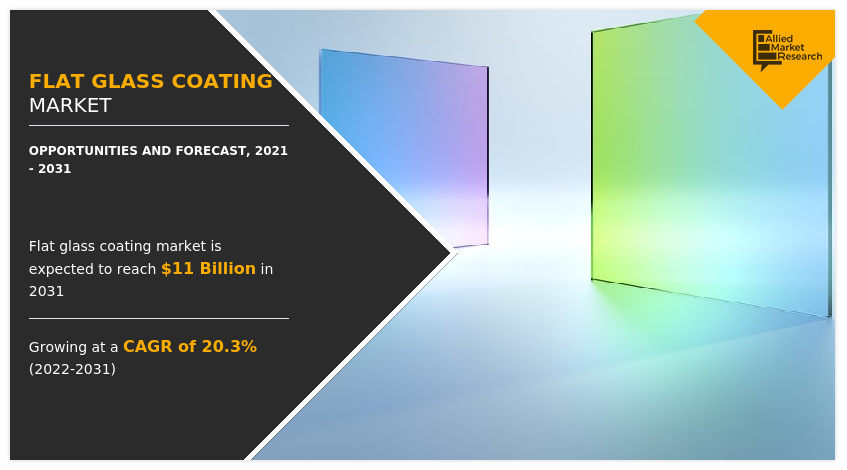
Increased interest in enhancing mirrors, which are often more expensive than standard mirrors, has resulted from an increase in expectations for everyday comforts and ways of living. The exploding interest in solar energy in emerging nations and the preference for solar energy in private applications have contributed to the global expansion of the solar PV glass industry, which drives the need for level glass coatings. Enhanced demands for day-to-day conveniences and ways of life have increased the demand for enhancing mirrors, which are often more expensive than standard mirrors. The exploding interest in solar energy in emerging nations and the preference for solar energy in private applications have contributed to the global expansion of the solar PV glass industry, which drives the need for level glass coatings. Over the past several years, there has been a global increase in interest in green buildings.
Green buildings offer many social, environmental, and financial benefits. Level glass coatings play a key role in reducing the building's operational costs. Consequently, a rise in the construction of green buildings will contribute directly to market expansion. The increasing flat glass coating cost might act as significant market restrictions. Due to the rising demand for green commercial building construction projects, the expansion of the worldwide market may be restricted. The growing number of green commercial building construction projects is raising the flat glass coating market's demand, hence creating new chances for manufacturers and industrialists. In addition, the rising usage of new technologies is expanding Glass Coating Companies' potential.
Segment Overview
The flat glass coating market is segmented on the basis of resin type, technology, application and region. Depending on resin type, the market is categorized polyurethane, epoxy, acrylic, and others (silicone and alkyd). On the basis of technology, the market is categorized into solvent-based, water-based, and nano coatings. On the basis of application, the market is categorized into mirror coatings, solar power, architectural, automotive, decorative and others. On the basis of region, the market is studied across North America, Europe, Asia-Pacific, and LAMEA.
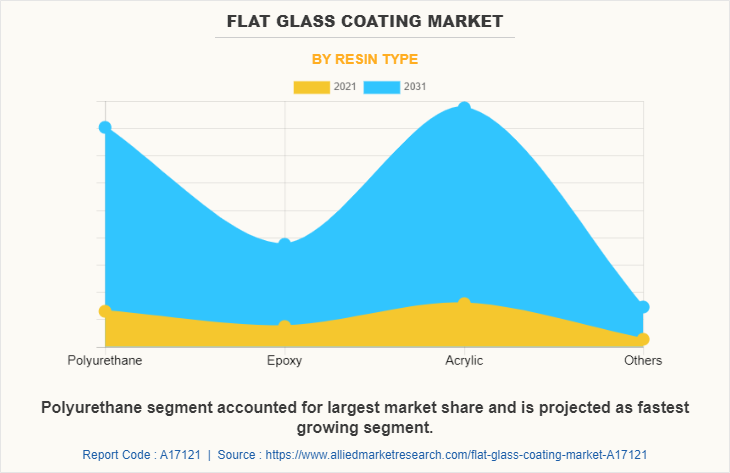
Flat Glass Coating Market By Resin Type
The acrylic segment accounted for the largest share i.e., 40.6% as it is widely used in architectural and automobile refinishing applications due to its excellent durability. Polyurethane segment is the fastest growing segment, growing around 21.4% CAGR during the forecast period owing to increasing use of polyurethane based glass coatings in automotive and transportation sectors.
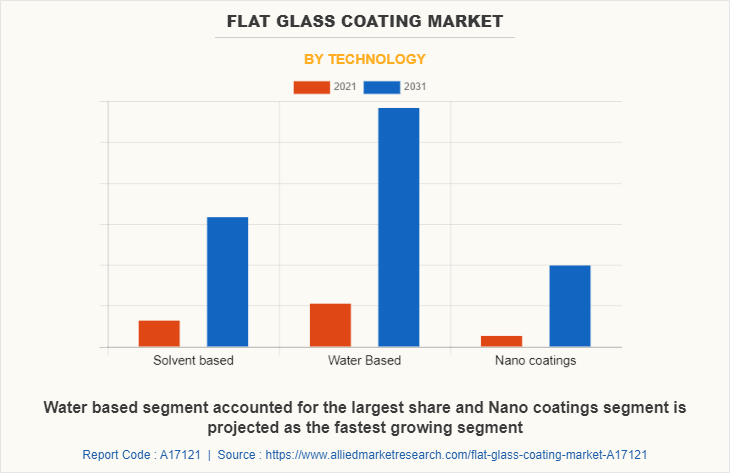
Flat Glass Coating Market By Technology
The water based segment accounted for the largest share i.e., 53.7%,as it has various advantege over other process and is widely used in waterproofing, damp proofing, crack filling, plaster additives and screed compound in construction industry. Nano coatings segment is the fastest growing segment, growing around 23.8% CAGR during the forecast period, as nano coatings is used in automobile and electronics manufacturing industry due to its chemical and physical properties like resistance to corrosion, abrasion, hardness, lubrication, transparency, and ductility.
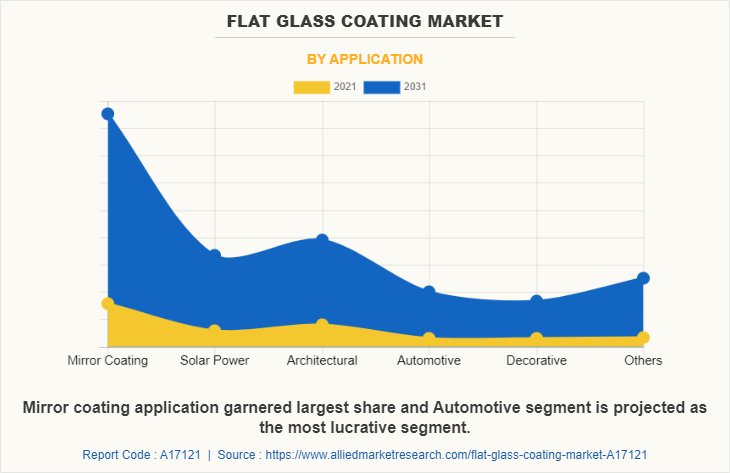
Flat Glass Coating Market By Application
The mirror coatings segment accounted for the largest share i.e., 40.7%, due to its architectural applications such as it is used in windows, doors, facades, and interiors to increase anti-reflection, thermal insulation, acoustic insulation, and transmission of certain solar wavelengths. Automotive segment is the fastest growing segment, growing around 23.0% CAGR during the forecast period, due to increased demand for dust- and water-repellent coatings from automotive industry.
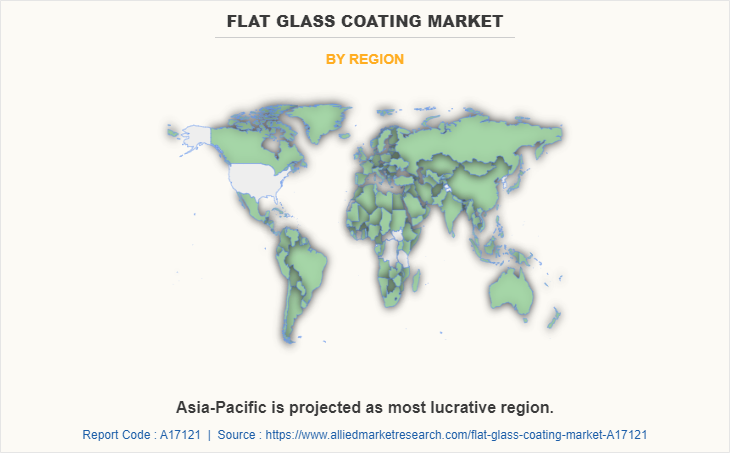
Flat Glass Coating Market By Region
South Korea is projected to be driven by increasing product application scope in solar panels. South Korea’s Ministry of Trade, Industry, and Energy (MOTIE) recently announced the development of a 2.1 GW floating solar power project in the Korean Peninsula. After completing, the project is expected to be 14 times larger than the current biggest floating solar installation, a 150 MW project in China's Panji District that is now under development.
Strong export demand and increasing consumer and investor confidence will support the expansion of the industrial construction industry in Japan. The increased demand from construction industry is expected to drive the flat glass coating market. Japan is projected to grow at CAGR 20.3% and South Korea is projected to grow at CAGR 17.8% during forecasted period.
Competitive Analysis
Major players operating in the global flat glass coatings market include 3M Company, Apogee Enterprises, Inc., Arkema Group, Be cool glass coating, FENZI SpA, Ferro Corporation, Gulbrandsen, Hesse GmbH & Co. KG, Nippon Paints Holdings Co. Ltd, Nukote Coating Systems International, PPG Industries Inc., The Sherwin-Williams Company, Unelko Corporation, Vitro, and Yantai Jialong Nano Industry Co., Ltd.
Other players operating in the flat glass coatings market are Vitro Architectural Glass, SunGuard, DIAMON-FUSION, and Tribos Coatings.
Key Benefits For Stakeholders
- This report provides a quantitative analysis of the market segments, current trends, estimations, and dynamics of the flat glass coating market analysis from 2021 to 2031 to identify the prevailing flat glass coating market opportunities.
- The market research is offered along with information related to key drivers, restraints, and opportunities.
- Porter's five forces analysis highlights the potency of buyers and suppliers to enable stakeholders make profit-oriented business decisions and strengthen their supplier-buyer network.
- In-depth analysis of the flat glass coating market segmentation assists to determine the prevailing market opportunities.
- Major countries in each region are mapped according to their revenue contribution to the global market.
- Market player positioning facilitates benchmarking and provides a clear understanding of the present position of the market players.
- The report includes the analysis of the regional as well as global flat glass coating market trends, key players, market segments, application areas, and market growth strategies.
Flat Glass Coating Market Report Highlights
| Aspects | Details |
| By Technology |
|
| By Application |
|
| By Resin Type |
|
| By Region |
|
| Key Market Players | Apogee Enterprises, Inc., FENZI SpA, 3M, Bee cool glass coating, PPG Industries, Yantai jialong Nano industry Co., Ltd, Yantai jialong Nano industry Co., Ltd., Ferro Corporation, Arkema Group, The Sherwin-Williams Company, Nippon Paints Holdings Co. Ltd, hesse gmbh & co. kg, Unelko Corporation, The Sherwin-Williams Company, Vitro, Hesse GmbH & Co. KG, Gulbrandsen, Nukote Coating Systems, Intl |
Analyst Review
According to the insights of the CXOs of leading companies, the growth of large-scale urbanization alongside a fast-rising population has been beneficial for the development of infrastructure on a worldwide scale. The vast majority of this expansion is being driven by increased spending on housing projects, which is anticipated to greatly expand the opportunities for flat glass coatings. The reason for this is due to the fact that residents will spend money on a variety of interior architectural items, such as mirrors and glass covers, which will assist the market to develop. Due to the fast development of Malaysia's construction industry, the majority of established firms located in Malaysia are targeting Japan and South Korea to raise their income and extend their market share. As a result, domestic producers such as PT Mulia Glass face substantial obstacles due to cheaper imports from Malaysia and growing production costs in Japan and South Korea as a result of rising energy prices.
Increasing demand from automobile and electronics manufacturing industry will drive the demand for flat glass coating during coming years.
Mirror coating is the leading application of Flat Glass Coating Market.
The flat glass coating market attained $1.9 billion in 2021, and is projected to reach $11.0 billion by 2031, growing at a CAGR of 20.3% from 2022 to 2031.
Asia-Pacific is the largest regional market for flat glass coating.
3M Company, Arkema Group, Ferro Corporation, Nippon Paints Holdings Co. Ltd, PPG Industries Inc., The Sherwin-Williams Company are the top companies to hold the market share in Flat Glass Coating.
Increase in demand for energy efficient buildings is driving the flat glass coating market.
COVID-19 has negative impact on flat glass coatings market owing to decreased demand from construction industry.
Loading Table Of Content...



